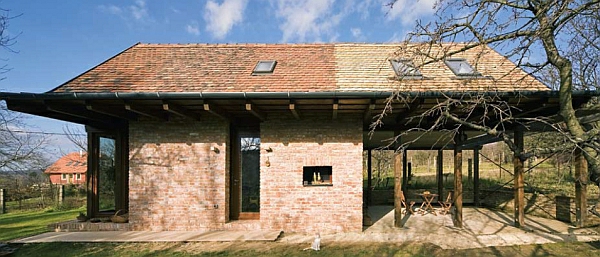Hidden Ecological Practice
Family Home in Budakeszi-Makkosmária, House of the Year Award 2010
Architects: Gábor Bártfai-Szabó, Orsolya Bártfai-Szabó
Text: Krisztián Dudics
Photos: Tamás Bujnovszky
Small is beautiful – says Ernst Schumacher, one of the pioneers of ecological economics in his epochal work. This lesson would be well worth for us to know, especially now, in the time of crisis, and especially for us, Hungarians. Because we are not only to be brave enough to dream something really big, but also to think in small – if this is the reality. Otherwise we shall find ourselves in a gap between dreams and reality. And what is most important: meanwhile we do not have to and we must not lgive up on quality.
Gábor and Orsolya Bártfai-Szabó are young architects married with two children and modest financial circumstances. Thus they looked for a swelling-place which is not far from Budapest where they have their work place but is still liveable, provides a healthy environment for adults and children alike – and is affordable.
Nestling in a picturesque environment, the neat Swabian has managed to preserve its identity even in the proximity of the capital, which results from the villagers’ respectful attitude to traditions, their diligence and attention to each other. The economy and small-scale industry of the settlement historically evolved was completed by orchards, and private gardens on the neighbouring southwestern slopes divided into thin strips. The Bártfai-Szabó family managed to purchase one of them, and although it was not „officially” allowed to have a house built here for permanent residence here (development was limited at 3%) – but they calculated that later on they can lay the foundations of their family home here which could be extended in the future. The architects were lucky as the area was meanwhile requalified and the extension of the original structure was feasible. The house completed was very close to the idea of the autonomous house. Compared to present-day standards it is unbelievably small with a net ground-space less than 30 m2 with thick walls of heat-insulating and heat-accumulating qualities. The operation and maintenance of the fully efficient house is independent of the sewer- and gas-system, consumes little electricity and water (the latter is also supplied from the well dug in the garden). Within the lot sewage cleaning is also solved, heating is provided by a modern programmable clean pellet boiler. There is no heat-pump in the house, solar collector or recuperating artificial ventillation, but they are not necessary either. This is a result of rational economy and a very clear and logical – ecological – thinking.
The majority of building materials used here – e.g. brick and tiles – are recycled from demolition or are recyclable, and their wide variety ranges from wood and heat insulation made of recycled newspaper through surface treatments, paints, shellacs to natural, chemical-free basic materials. All this reflects highly conscious selections and decisions with regard to financial means, sustainability for a whole life-cycle as well as to good general condition and health. All this is so convincingly simply and naturally presented by this house and the host that we just do not understand why it is not the general practice yet.
Extendability is not only something shown off in blueprints – the scheme sketches preferred by architects – but is also reasonably viable: the first phase of extension, that of the attic above the terrace has already been finished and proves to be perfect. Defining the main view of the house also present in the structure, the symmetry, the characteristic corner design, the fine surfaces of brick and wood beautiful in their casual way simultaneously embody the rustic atmosphere associated with gardens and life in the countryside as well as that of Zeitgeist. Deeply recessed from the plane of the elevation, windows make exterior surfaces highly sculpturesque, also making the width of walls perceptible from the outside (for the same reason, however, the congruous lack of thermal bridges is slightly compromised). The proportion of openings seem to be too small on the southern side (especially because the eaves protects the facade from sunshine in summer), but when viewed from the inside it proves to be just enough.
All in all, this house has found its best place whilst striking great architecture from the miniature scales. As its designers say the architectural design was mainly Gábor’s job, whilst Orsolya specialized in functional aspects during the designing process. It is not unprecedented, though: Gábor Bártfai-Szabó came up with such a good house after some of his previous designs published in architectural press in the past few years also prove it. As this building is similar to those as far as energetic objectives are concerned, the comparison with the almost passive one in Pilisszentlászló naturally presents itself (I wrote about the latter in MÉ before, see issue 2008/1). It is both interesting and instructive that besides energetic qualities it is differences in every aspect that are striking – and the house in Budakeszi gives realistic answers exactly by these characteristics to the vindications I had then. Whilst that one is a huge and expensive building separated from its environment just like a rezervation, this is an open, friendly, inexpensive and small house. While that artificial building materials were used for the former and it is equipped with artificial air conditioning created by engineering systems, the latter has remained part of its environment owing to its natural materials and the lack of mechanics. Whilst the former one was built without sparing money and energy, in line with a manager’s approach, here the designer-architect was thinking in simplicity, decently and with flexible spontaneity. And at last but not least: whilst it was difficult to discover architectural quality in the former design, this house in Budakeszi embodies a more genuine kind of architecture.
Architects: Bártfai-Szabó Orsolya és Bártfai-Szabó Gábor, Bártfai-Szabó Építésziroda Kft.
Installation: Gregó Tibor
Main contractor: Wet-Bau Kft.
Insulation: Pezowood Kft. (Isocell)
Doors and windows: Fenyőtherm Kft.





